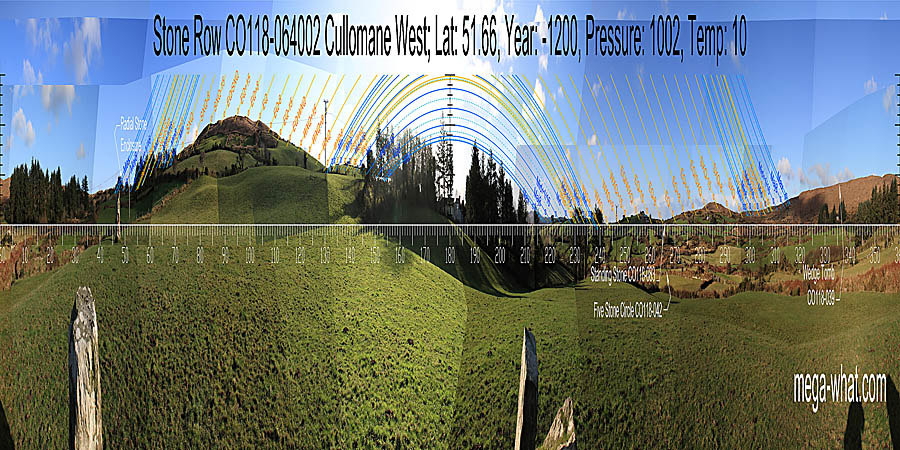 Cullomane West Stone Row is about 3km south-west of Bantry. The north-east stone is upright, the centre one is fallen, the south-western one is split and leaning.
A tall Standing Stone is about 20m ENE of the Stone Row.
Cullomane West Stone Row is about 3km south-west of Bantry. The north-east stone is upright, the centre one is fallen, the south-western one is split and leaning.
A tall Standing Stone is about 20m ENE of the Stone Row.
South is obscured. It is on the western slope of a hill and eastern side of a dip, possibly close to the intersect of local and further horizons [Pic]. The eastern luni-solar sequence runs over a rise. The western luni-solar sequence runs through a dip. North is close to a hilltop [Pic].
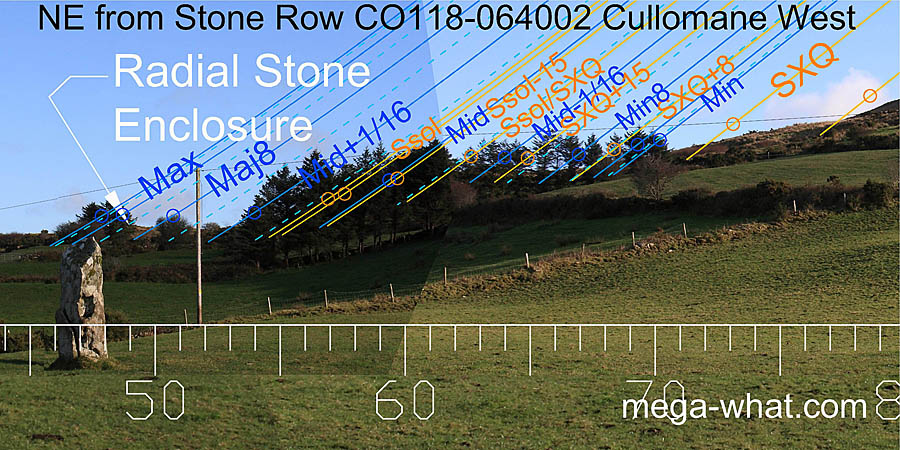 The north-eastern row axis is north of the lunar limit which occurs roughly above Radial Stone Enclosure CO118-085.
The major eighth is just south of it and the next lunar sixteenth is at the basal step of Spratt Hill. The lower hill slopes are then obscured.
The north-eastern row axis is north of the lunar limit which occurs roughly above Radial Stone Enclosure CO118-085.
The major eighth is just south of it and the next lunar sixteenth is at the basal step of Spratt Hill. The lower hill slopes are then obscured.
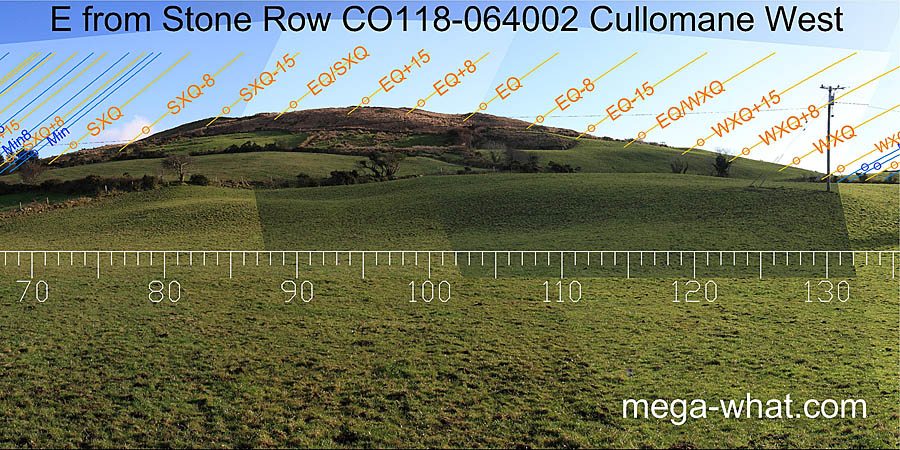 The upper slopes and hilltop provide a number of useful markers for the central part of the year.
The upper slopes and hilltop provide a number of useful markers for the central part of the year.
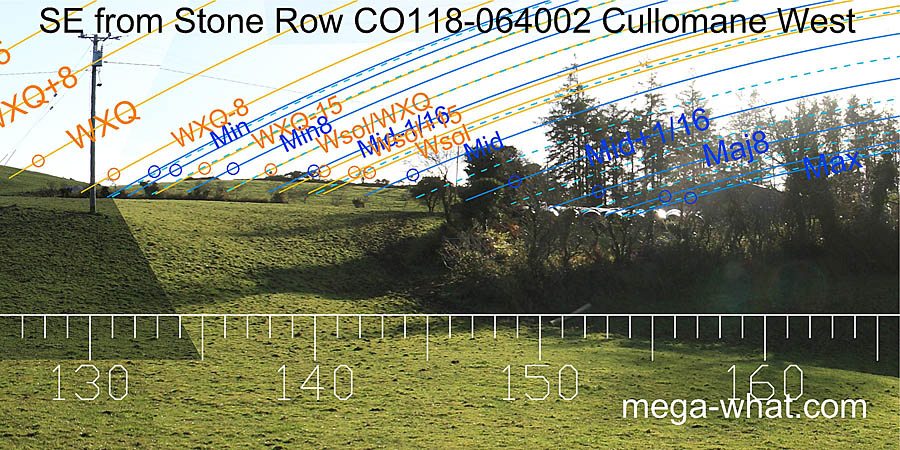 The south-eastern horizon is quite close but partly obscured.
Spratt Hill's basal dip is a quarter-month south of the winter cross-quarter which is a commonly used delimiter for the lunisticeLunistices are the most northerly and southerly moons of the month. The lunar equivalent of solstices - more.
range.
The south-eastern horizon is quite close but partly obscured.
Spratt Hill's basal dip is a quarter-month south of the winter cross-quarter which is a commonly used delimiter for the lunisticeLunistices are the most northerly and southerly moons of the month. The lunar equivalent of solstices - more.
range.
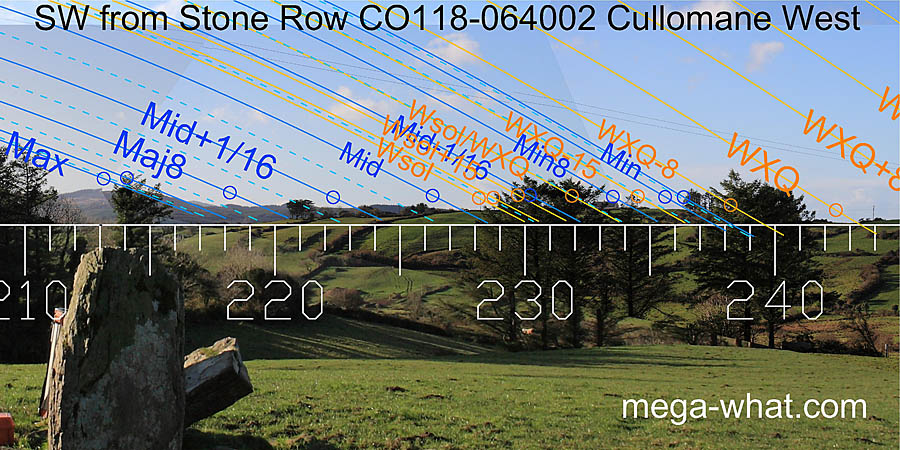 South-westwards, the row axis indicates the lunar limit on a hilltop and its adjacent sixteenth occurs at the intersect notch between this hill and Mt Gabriel,
the shallow north facing slope making for high precision. The dip in the centre of the ridge west of Mt Gabriel is the major eighth.
The ridge continues on to Mt Corrin which is not significant but the intersect with nearer ground marks the lunar midpoint.
The first local high point is the adjacent sixteenth and the second is the lunar minor eighth. The dip beyond that is the cross-quarter.
South-westwards, the row axis indicates the lunar limit on a hilltop and its adjacent sixteenth occurs at the intersect notch between this hill and Mt Gabriel,
the shallow north facing slope making for high precision. The dip in the centre of the ridge west of Mt Gabriel is the major eighth.
The ridge continues on to Mt Corrin which is not significant but the intersect with nearer ground marks the lunar midpoint.
The first local high point is the adjacent sixteenth and the second is the lunar minor eighth. The dip beyond that is the cross-quarter.
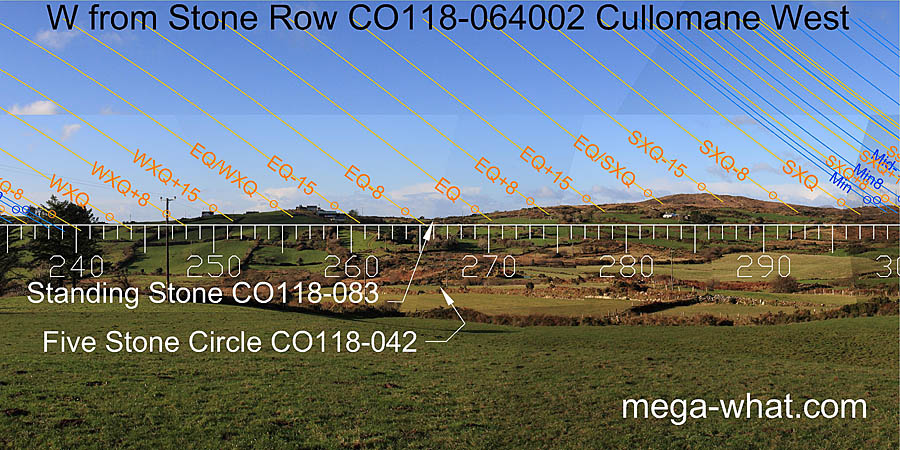 The western ridge has three large dips with cross-quarters in the outer two.
The central dip is not an accurate marker from either row or Standing Stone but Standing Stone CO118-083 is visible there.
This stone is a quarter-month south of the equinox when viewed from Standing Stone CO118-064001 and would quite possibly cut a vegetation free horizon.
The western ridge has three large dips with cross-quarters in the outer two.
The central dip is not an accurate marker from either row or Standing Stone but Standing Stone CO118-083 is visible there.
This stone is a quarter-month south of the equinox when viewed from Standing Stone CO118-064001 and would quite possibly cut a vegetation free horizon.
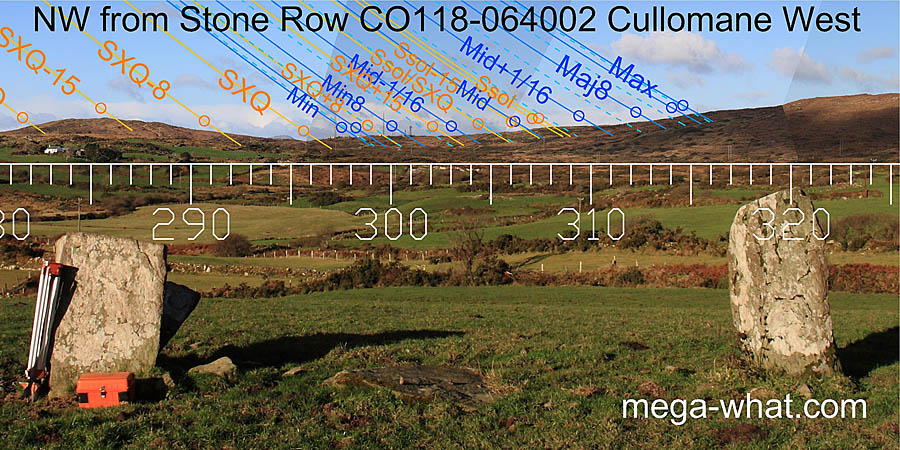 North of summer cross-quarters are a humpy bumpy area that would have given good markers for the minor end of the lunisticeLunistices are the most northerly and southerly moons of the month. The lunar equivalent of solstices - more.
range as well as more solar points.
The lower slopes of Knocknaveagh provides a few more accurate markers to terminate the sequence.
North of summer cross-quarters are a humpy bumpy area that would have given good markers for the minor end of the lunisticeLunistices are the most northerly and southerly moons of the month. The lunar equivalent of solstices - more.
range as well as more solar points.
The lower slopes of Knocknaveagh provides a few more accurate markers to terminate the sequence.
This is the most easterly of a local group of three stone rows, five in number and all low in height. Dereenagreanagh, 911m to the west is the nearest but there is also another one, morphologically very similar to these, 12.6km to the east-north-east at Leitry Lower.
- A five stone circle is visible 230m due west but is in the townland of Baurgorm. There is a possible fallen Standing Stone beside it.
- Another five stone circle is 1.1km to the north-north-east. Also in Baurgorm, this one has an accompanying Stone Pair.
References
- Archaeological Survey of Ireland, record details. www.archaeology.ie/archaeological-survey-ireland
- POWER, D. et al. 1992 Archaeological Inventory of County Cork, Volume 1: West Cork. Dublin: Stationary Office. p35:no.142, p53:no.291.
- RUGGLES, C.L.N. 1999 Astronomy in Prehistoric Britain and Ireland. Newhaven & London: Yale University Press. CKR78.
